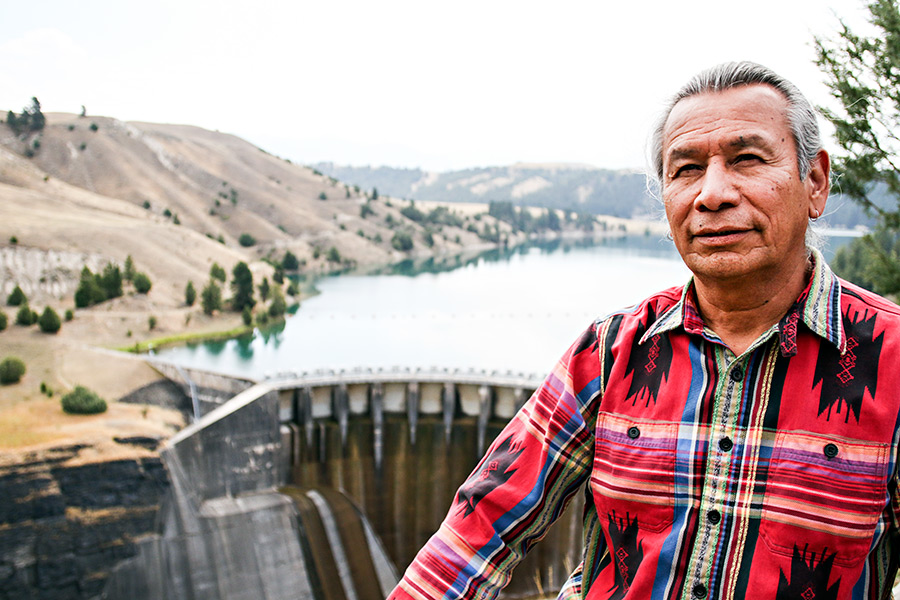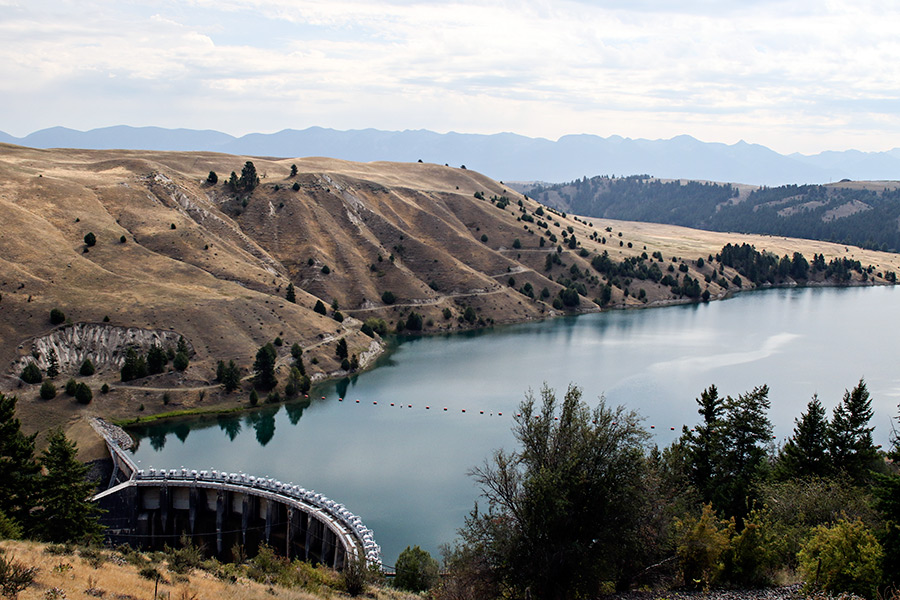CSKT Prepares for Historic Acquisition of Kerr Dam
Public ceremony Sept. 5 in Pablo to celebrate first tribes in the U.S. to own and operate a major hydroelectric facility
By Dillon Tabish
Ever since it emerged last century, the Kerr Dam has represented a prominent and divisive landmark on the Flathead Indian Reservation.
Animosities can run deep for the Confederated Salish and Kootenai Tribes, tracing back to when a subsidiary of Montana Power Company disregarded opposition among tribal members and built the massive concrete structure five miles below the southern shores of Flathead Lake in the middle of the reservation at a section of river considered sacred by the tribes.
Now, an historic symbol of authority and a long-standing source of tension is coming full circle for the CSKT and its chairman, Vernon Finley, whose great-grandfather, Koostahtah, was chief of the Kootenais when Kerr Dam was built in the 1930s.
The tribes assume ownership of the dam on Sept. 5, completing a decades-long process that culminates with them becoming the first tribal government to own and operate a major hydroelectric facility. The CSKT paid nearly $18.3 million for the facility, which will be operated by Energy Keepers, Inc., a tribally owned corporation that will sell the electricity it produces on the open market.
A public ceremony is scheduled for that Saturday from 10 a.m.- 2 p.m. inside the gymnasium of Salish Kootenai College in Pablo.
The dam, named after the president of Montana Power when it was built, will be renamed, and the CSKT collected ideas from the community in the months leading up to the acquisition. Finley said the Tribal Council has not yet decided on a new name.
The new name and acquisition will both represent a significant turning point.
Economically, the dam will provide the CSKT a sizeable source of revenue. The 194-megawatt power plant produces an average of 1.1 million megawatt-hours of electricity per year, enough to power more than 100,000 homes annually. It can generate up to $60 million a year on the wholesale market in the West, depending on energy prices. Energy Keepers has spent the last year preparing for the acquisition by hiring and training employees who will run the site locally.
Brian Lipscomb, CEO of Energy Keepers, said the company is ready with new staff and computer systems in place that will modernize many aspects of the dam and its complex operations.
“Everything is falling into place as it should,” he said. “The team we’ve assembled is top notch. We’ve got some really qualified folks who joined the team, both tribal members and non-tribal members. They’ve done a lot of work in the last year. Things are coming together as expected.”
A board of directors, appointed by the CSKT tribal government, will oversee Energy Keepers. The board is made up of chairman Thomas Farrell, vice chairman Daniel Decker, secretary Robert Gauthier, Thomas Babineau and Lon Topaz.
Energy Keepers will assume the same responsibilities and regulations as NorthWestern Energy and other operators in the past in terms of managing the dam and its vital counterpart, Flathead Lake.
The creation of the dam in 1938 raised the level of the lake by 10 feet, adding an additional 1.2 million acre feet of storage.
The tribes will still be required to manage the lake under the previous FERC license that set environmental and regulatory standards for the lake. This spring the company worked closely with NorthWestern Energy amid drought conditions that forced a management plan to be enacted to preserve the lake elevation at 2,892 feet.
“We were successful this year in an unprecedented drought year,” Lipscomb said.
He added, “There’s some paranoia in the community that we don’t have to follow regulations, which is odd, or that we won’t be able to manage this correctly. We’ve done a lot of things quite well. We have managed Mission Valley Power for almost 30 years and that’s a sophisticated endeavor.”
Lipscomb said the acquisition of the dam will also mean Flathead Lake will be managed locally instead of by an out-of-state company.
“We’ll have the capacities and capability to engage in this regional conversation about Flathead Lake from right here on the shores of Flathead Lake,” he said.

The significance of the acquisition spans beyond economics, too.
After the reservation was opened to non-tribal homesteaders, efforts were made to establish an irrigation system for the region to help settlers. There were also the booming mining operations in Anaconda and Butte that needed electricity from any source in the region.
The first power site investigation on the Flathead River was made in 1909. The planning dragged on for decades until the Rocky Mountain Power Co. — a subsidiary of Montana Power — stated that it was ready to break ground on an $8 million power plant and dam. It was a contentious proposal; the massive project was to be built on a scenic section of river with intense drops, known by the tribal members as the “Place of the Falling Waters.” Tribal members camped near the site in opposition while Koostahtah and other leaders negotiated with the power company about the transformative development.
The project moved forward in the spring of 1930, employing more than 1,200 people at the height of construction. Wages ranged from 40 cents an hour for less-skilled workers to $2 an hour for those with higher skills. Construction was halted the following year amid the Great Depression and the project sat stalled for five years. During that time the CSKT organized itself as the first formal tribal government under the 1934 Indian Reorganization Act in response to the ongoing efforts to build a dam as well as the creation of the expansive Flathead Indian Irrigation Project, which became the largest irrigation system in the state.
In 1935, the CSKT ratified its constitution and created an elected government of 10 tribal council representatives and the last two federally recognized head chiefs, Charlo and Koostahtah.
Construction resumed in 1936 and the dam was completed in 1938. Fourteen lives were lost during the development, including several tribal members.
“How it went through was something that he worked hard at negotiating at the time,” Finley said of his great-grandfather. “He knew it was going to happen but he was trying to make it happen in a way that would have the least negative effect on the people as possible. The fact that lives were lost troubled him greatly. Perhaps he gave up too much.”
Now, for Finley and the roughly 5,000 tribal members who live on the reservation, the landmark that has symbolized painful memories is transforming into a source of strength.
“There’s great happiness and there’s also great sorrow. This is a spiritual place for us,” Finley said last week at the Kerr Dam Overlook.
Finley said he is grateful to be serving as tribal chairman when CSKT is achieving this milestone.
“Our paths are set for us and we just walk them. So for me personally, I always take time to stop and be thankful for the path that was chosen for me and the path that I’ve been on,” he said.
“There have been so many great people with so many efforts getting to this point. For me to be able to experience it right here is really a blessing that I don’t take lightly.”